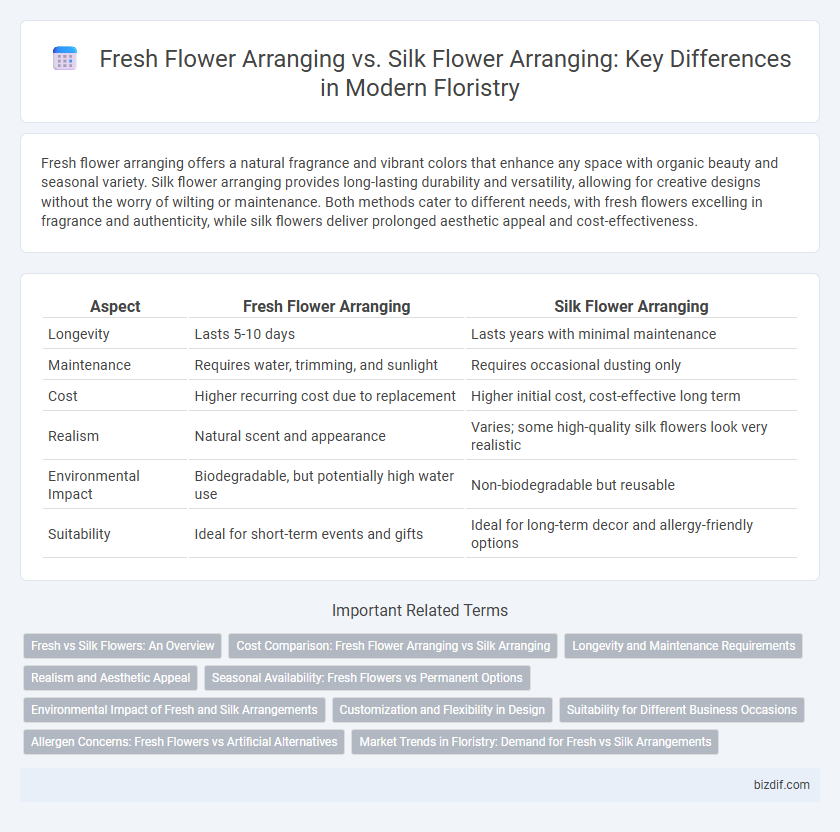Fresh flower arranging offers a natural fragrance and vibrant colors that enhance any space with organic beauty and seasonal variety. Silk flower arranging provides long-lasting durability and versatility, allowing for creative designs without the worry of wilting or maintenance. Both methods cater to different needs, with fresh flowers excelling in fragrance and authenticity, while silk flowers deliver prolonged aesthetic appeal and cost-effectiveness.
Table of Comparison
| Aspect | Fresh Flower Arranging | Silk Flower Arranging |
|---|---|---|
| Longevity | Lasts 5-10 days | Lasts years with minimal maintenance |
| Maintenance | Requires water, trimming, and sunlight | Requires occasional dusting only |
| Cost | Higher recurring cost due to replacement | Higher initial cost, cost-effective long term |
| Realism | Natural scent and appearance | Varies; some high-quality silk flowers look very realistic |
| Environmental Impact | Biodegradable, but potentially high water use | Non-biodegradable but reusable |
| Suitability | Ideal for short-term events and gifts | Ideal for long-term decor and allergy-friendly options |
Fresh vs Silk Flowers: An Overview
Fresh flower arranging offers vibrant colors, natural scents, and seasonal variety, making each bouquet unique and lively, while silk flower arranging provides long-lasting durability, allergy-friendly options, and year-round availability without wilting. Fresh flowers require careful maintenance and have limited lifespan, whereas silk flowers need minimal care and maintain consistent appearance over time. Both styles cater to different aesthetic preferences and functional needs in floristry, balancing freshness with practicality.
Cost Comparison: Fresh Flower Arranging vs Silk Arranging
Fresh flower arranging typically incurs higher costs due to the need for purchasing seasonal blooms and frequent replacements, with average prices ranging from $50 to $200 per arrangement. Silk flower arranging involves a larger initial investment, often between $100 and $300, but offers long-term savings as silk flowers are reusable and require minimal maintenance. Budget-conscious florists and decorators often weigh fresh flowers' vibrant natural appeal against silk flowers' durability and cost-effectiveness for recurring displays.
Longevity and Maintenance Requirements
Fresh flower arranging offers vibrant natural beauty but requires frequent water changes, trimming, and replacement due to limited lifespan of a few days to weeks. Silk flower arranging provides long-lasting decorative appeal with minimal maintenance, needing only occasional dusting to retain its appearance for years. Choosing between the two depends on whether users prioritize the authentic look of fresh blooms or the durability and ease of care offered by silk flowers.
Realism and Aesthetic Appeal
Fresh flower arranging offers unmatched realism with natural colors, textures, and fragrances that enhance aesthetic appeal, making each arrangement a unique living art piece. Silk flower arranging provides long-lasting beauty and consistent appearance, allowing intricate designs without the limitations of seasonal availability or wilting. While fresh flowers captivate with organic authenticity, silk flowers excel in durability and maintenance-free elegance for extended decorative use.
Seasonal Availability: Fresh Flowers vs Permanent Options
Fresh flower arranging depends heavily on seasonal availability, with blooms varying by climate and time of year, making certain flowers inaccessible during off-seasons. Silk flower arranging offers permanent options unaffected by seasons, ensuring consistent availability and long-lasting arrangements ideal for year-round decor. Opting for fresh flowers provides natural fragrance and vibrant hues, while silk flowers deliver versatility and durability without the constraints of seasonal changes.
Environmental Impact of Fresh and Silk Arrangements
Fresh flower arranging involves biodegradable blooms that decompose naturally, reducing landfill waste and lowering carbon footprints due to local sourcing and seasonal availability. Silk flower arrangements, though reusable and long-lasting, often rely on synthetic materials derived from petrochemicals and require energy-intensive manufacturing processes, contributing to environmental pollution. Choosing fresh flowers supports sustainability through organic growth cycles, whereas silk flowers offer durability but pose challenges in recycling and ecological impact.
Customization and Flexibility in Design
Fresh flower arranging offers unparalleled customization with seasonal blooms, allowing for unique textures, scents, and vibrant colors that change throughout the year, creating dynamic, one-of-a-kind designs. Silk flower arranging provides greater flexibility in design longevity and placement, enabling intricate arrangements that withstand various environmental conditions without wilting or fading. Both methods cater to personalized aesthetics, but fresh flowers excel in organic variation while silk flowers support permanent, versatile decor solutions.
Suitability for Different Business Occasions
Fresh flower arranging suits corporate events, weddings, and luxury retail spaces due to its natural fragrance and vibrant colors that create a sophisticated ambiance. Silk flower arranging is ideal for long-term displays in offices, hotels, and conference centers where maintenance-free, durable decor is essential. Both options offer unique advantages: fresh flowers provide a sensory experience while silk flowers ensure longevity and cost-effectiveness.
Allergen Concerns: Fresh Flowers vs Artificial Alternatives
Fresh flower arranging often triggers allergies due to pollen and fragrance emissions, affecting sensitive individuals with symptoms like sneezing, itching, or respiratory issues. Silk flower arranging offers a hypoallergenic alternative, as artificial flowers contain no pollen, making them suitable for environments where allergy concerns are paramount. Choosing silk over fresh flowers can improve indoor air quality and reduce allergy-related discomfort, especially in healthcare facilities, offices, and event spaces.
Market Trends in Floristry: Demand for Fresh vs Silk Arrangements
Market trends in floristry reveal a steady demand for fresh flower arrangements driven by their natural beauty and fragrance, appealing to events and upscale clients seeking authenticity. Conversely, silk flower arrangements gain popularity for their longevity, low maintenance, and versatility in home decor and commercial displays, catering to budget-conscious consumers and businesses. The growing preference for sustainable and reusable floral options further propels the silk flower market, while freshness and seasonality continue to define the fresh flower segment.
Fresh Flower Arranging vs Silk Flower Arranging Infographic

 bizdif.com
bizdif.com